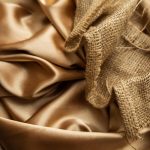Are you someone who loves luxurious fabrics and enjoys indulging in high-quality bedding and clothing? If so, you may have come across the terms ‘satin’and ‘sateen’while shopping. While these two fabrics may seem similar at first glance, they actually have distinct differences that set them apart.
Understanding these differences can help you make informed decisions when purchasing bedding or clothing made from these materials. In this article, we’ll explore the composition, texture, weave patterns, durability, appearance, uses, and care of satin and sateen fabrics, so you can determine which one is right for you.
So, let’s dive in and explore the fascinating world of these two luxurious fabrics.
Table of Contents
Composition of Satin and Sateen
Let’s take a closer look at what makes satin and sateen differ in terms of their composition. Satin is typically made from silk, but it can also be made from polyester or other synthetic fibers. This fabric is known for its glossy surface and smooth texture. Satin is woven using a technique called satin weave, which creates a lustrous and shiny finish on one side of the fabric.
On the other hand, sateen is primarily made from cotton, although it can also be made from rayon or polyester. Unlike satin, sateen has a matte finish and a softer texture. Sateen is woven using a technique called sateen weave, which forms a compact and dense structure. This weave pattern gives sateen its characteristic silky feel, similar to that of satin.
Although both satin and sateen have a similar look and feel, they have different compositions that affect their durability and care requirements. Satin is more delicate and prone to snagging, while sateen is more durable and easier to care for. When it comes to choosing between satin and sateen, it’s important to consider the fabric’s composition and how it will fit into your lifestyle.
Texture of Satin and Sateen
You can feel the difference in the texture of satin and sateen when you run your hand over them. Satin has a smooth, glossy finish, and the texture is very soft and silky. On the other hand, sateen has a slightly rougher texture and a matte finish.
While both fabrics have a luxurious feel, the texture of satin is more slippery and delicate, while sateen is more durable and substantial. To understand the difference in texture between satin and sateen, it’s helpful to know how they are made.
Satin is typically made from silk or polyester fibers that are woven in a way that creates a smooth, shiny surface. Sateen, on the other hand, is made from cotton fibers that are woven in a way that creates a more textured surface. This difference in weaving creates the different textures that you can feel when you touch the fabrics.
When it comes to choosing between satin and sateen, the texture is just one factor to consider. Satin is often used for formal occasions because of its elegant appearance and delicate feel. Sateen, on the other hand, is more versatile and can be used for a wider range of projects, from bedding to clothing.
Ultimately, the choice between satin and sateen will depend on your personal preferences and the specific project you’re working on.
Weave Patterns
We can appreciate the intricate patterns of weaving that create distinct textures in fabrics like satin and sateen. When it comes to weave patterns, satin is created using a satin weave, which involves four or more weft threads floating over a warp thread, creating a smooth and shiny surface.
On the other hand, sateen is created using a satin weave structure but with a different arrangement of threads. In sateen, the weft threads are floated over multiple warp threads, creating a softer and less shiny surface than satin.
Satin and sateen’s weave patterns create different properties in the fabric. Satin is known for its glossy surface, which is perfect for formal attire like evening gowns and luxurious bedding. The smooth surface of satin also allows it to drape elegantly, making it a popular choice for bridal wear.
Sateen, on the other hand, has a softer and more matte surface, making it ideal for casual wear and home decor. Its softness also makes it comfortable to sleep on, and sateen sheets are known for their durability and long-lasting quality.
The weave patterns of satin and sateen are what differentiate them from each other. Satin’s satin weave creates a smooth and shiny surface, while sateen’s satin weave structure with a different thread arrangement creates a soft and less shiny surface. These differences make them suitable for different types of clothing and home decor.
Whether you prefer the luxurious sheen of satin or the softness of sateen, both fabrics are versatile and beautiful in their own way.
Durability
The durability of these fabrics is an important factor to consider when selecting between them. Satin is known for its delicate nature, which makes it prone to snagging and tearing easily. While it may look luxurious and feel soft to the touch, it may not be the best option for high-traffic areas or frequent use.
On the other hand, sateen is generally more durable due to its tighter weave pattern, making it a better choice for upholstery or bedding that will see a lot of wear and tear. To ensure the longevity of your satin or sateen fabric, there are a few things you can do.
First, always read the care instructions before washing or cleaning the material. Satin should typically be hand washed or dry cleaned, while sateen can usually be machine washed on a gentle cycle. Second, avoid using harsh detergents or bleach, as these can weaken the fibers and cause the fabric to break down faster.
Finally, try to limit direct exposure to sunlight or heat, as this can cause fading and deterioration over time. When it comes to durability, sateen may be the better choice for those looking for a long-lasting fabric. However, with proper care and use, satin can still be a beautiful and luxurious option for special occasions or decorative purposes. Ultimately, the decision between satin and sateen will depend on your specific needs and preferences, but knowing the durability factors can help you make an informed choice.
- Always read the care instructions before washing or cleaning the fabric.
- Avoid using harsh detergents or bleach, as these can weaken the fibers.
- Limit direct exposure to sunlight or heat to prevent fading and deterioration.
- Sateen may be a better choice for high-traffic areas or frequent use.
Appearance
When it comes to appearance, you’ll find that satin and sateen have distinct differences. Satin has a luxurious look that’s often associated with elegance and sophistication. On the other hand, sateen has a subtle shine that provides a more understated and modern feel.
Understanding these differences can help you choose the right fabric for your bedding or clothing needs.
Satin’s Luxurious Appearance
With its smooth and shiny surface, satin creates a luxurious and elegant look. Its lustrous finish reflects light in a way that no other fabric can, giving it a rich and sensual appearance.
Satin is often used in high-end fashion and formal wear due to its sophisticated look that exudes opulence and glamour. If you’re looking to elevate your style game, satin is the perfect fabric to add to your wardrobe.
Here are three reasons why satin’s luxurious appearance is worth investing in:
- Satin’s smooth surface feels soft and silky against the skin, making it comfortable to wear for extended periods of time.
- The fabric’s sheen can make any color pop, creating a vibrant and eye-catching look.
- Satin’s elegance is timeless and classic, making it a versatile option for any occasion, from weddings to red carpet events.
Sateen’s Subtle Shine
You’ll notice a subtle shine on sateen fabric, giving it a smooth and polished appearance. This is due to the weaving process, which uses a satin weave structure with more weft threads on top of the warp threads. This results in a surface that reflects light differently from a standard weave, creating a slight sheen.
The subtle shine of sateen fabric can add a touch of elegance to any room. It’s a popular choice for bedding, as it provides a cozy and comfortable feel while also looking luxurious.
Sateen is also known for its durability, making it a practical choice for everyday use. So if you’re looking for a fabric with a bit of shine and a lot of durability, sateen might be the perfect choice for you.
Uses of Satin and Sateen
One great way to add a touch of luxury to your home decor is by incorporating satin or sateen fabrics. These fabrics are perfect for creating elegant bedding, drapes, and upholstery. Satin and sateen fabrics have a soft and smooth feel, making them ideal for creating a cozy and comfortable environment in your home.
If you’re looking for a fabric that can add a touch of sophistication to your bedroom, satin bedding is a great option. Satin sheets, pillowcases, and duvet covers can give your bedroom a luxurious and glamorous look. They’re also easy to care for and can last for many years, making it a worthwhile investment.
Sateen fabrics, on the other hand, are perfect for creating elegant drapes and upholstery. Sateen has a subtle sheen that adds a touch of glamour to any room. Additionally, sateen is durable and can withstand wear and tear, making it a great option for high-traffic areas in your home.
Whether you’re looking to create a cozy bedroom or a glamorous living room, satin and sateen fabrics are great options for adding a touch of luxury to your home decor. So, invest in high-quality satin and sateen fabrics for long-lasting durability and beauty.
Care and Maintenance
Maintaining the beauty of your luxurious satin or sateen fabrics is important to ensure their longevity. To keep these fabrics looking their best, it’s important to follow the care instructions carefully.
Both satin and sateen fabrics are delicate and require special attention when it comes to washing and drying. When cleaning these fabrics, it’s best to avoid using harsh chemicals and detergents. Instead, opt for a mild detergent and wash the fabric in cold water on a gentle cycle.
Avoid wringing or twisting the fabric as this can cause damage to the delicate fibers. After washing, it’s important to air dry both satin and sateen fabrics. Avoid using a dryer as the high heat can damage the fibers and cause shrinkage.
Instead, lay the fabric flat on a clean, dry towel and allow it to air dry naturally. With proper care and maintenance, your satin and sateen fabrics will continue to look luxurious for years to come.
- Is Pure Chiffon Costly? - April 23, 2024
- What Is Similar to Chiffon? - April 23, 2024
- Which Material Is Better Crepe or Chiffon? - April 23, 2024




